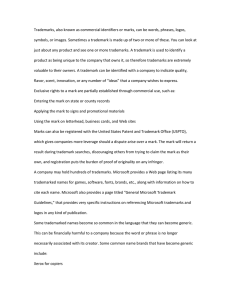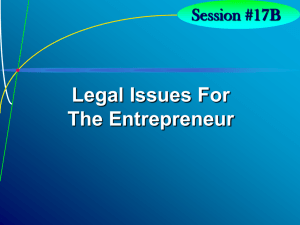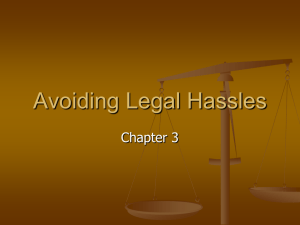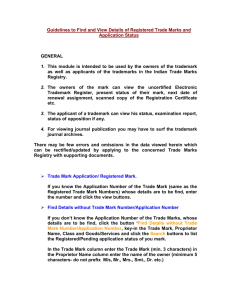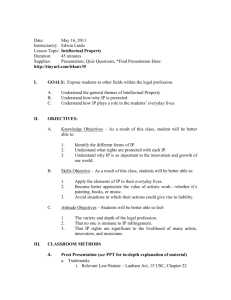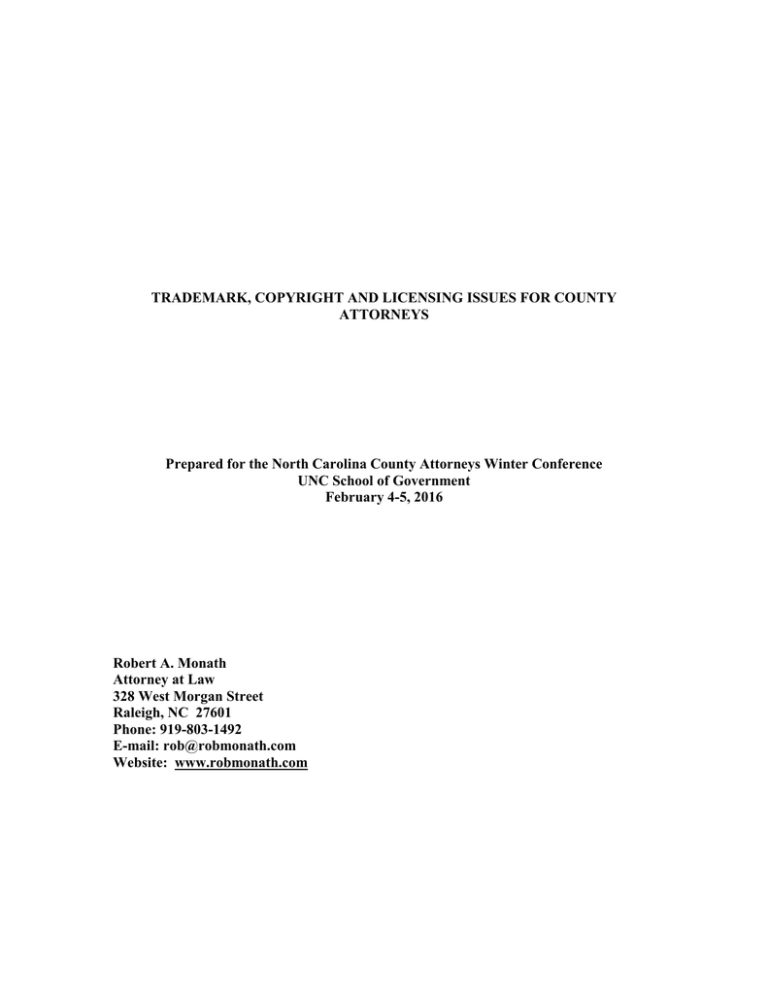
TRADEMARK, COPYRIGHT AND LICENSING ISSUES FOR COUNTY
ATTORNEYS
Prepared for the North Carolina County Attorneys Winter Conference
UNC School of Government
February 4-5, 2016
Robert A. Monath
Attorney at Law
328 West Morgan Street
Raleigh, NC 27601
Phone: 919-803-1492
E-mail: rob@robmonath.com
Website: www.robmonath.com
I.
INTRODUCTION
County governing boards increasingly are presented with trademark, copyright and licensing
issues. Some of the most prevalent topics include identifying and managing common types of
intellectual property typically owned or managed by counties, such as publicly commissioned
works of art, county-sponsored programs, and economic and tourism promotional materials.
Of particular importance are county seals and other insignia. The City of Houston was recently
denied federal trademark registration for its city seal. In re City of Houston, 731 F. 3d 1326
(D.C. Cir. 2013) held that language in the Federal Lanham Act, which is identical to language
in North Carolina’s trademark registration law, is a complete bar to the registration of seals and
insignias. Following the Houston ruling, the North Carolina Secretary of State has announced
the suspension of its longstanding practice of permitting the registration of local government
seals and insignia.
Intellectual property law is divided into four basic areas: copyrights; trademarks; patents; and
trade secrets. Two of these – copyrights and trademarks – are particularly relevant for local
governments. The following outline provides a brief overview of these and related areas.
II.
COPYRIGHTS
A.
Definition
U.S. copyright law protects original works of authorship. Copyrights exist automatically, as
soon as a work is fixed in a tangible form. For additional remedies and protection, and as a
pre-requisite for enforcing a copyright in federal court, works should be registered with the
U.S. Copyright Office.
A copyright owner enjoys a “bundle” of separate and distinct rights, including the right to: (i)
reproduce a work; (ii) make derivations of the work; (iii) sell copies of the work; (iv) perform
the work for the public; (v) display the work to the public; and (vi) license any of the foregoing
rights in the work to others.
Copyright law protects literary works (including computer programs); musical works; dramatic
works; pictorial, graphic, and sculptural works (including maps); motion picture and other
audiovisual works; sound recordings; and architectural works. Copyright law protects
materials on websites and in electronic databases, as well as in hard copy.
B.
Copyright Notice
Under current law, it is no longer necessary to place a copyright notice on a work to protect it.
Even though it is not essential, however, a copyright notice is highly recommended because it
alerts the public to one’s rights in a copyrighted work. It also prevents any infringer of a
copyright from claiming an “innocent infringer” defense – that is, that the infringer should not
be liable for unauthorized use of the work because he or she did not realize it was protected by
copyright. If the notice is used, it should include three things: (i) the copyright symbol © and
the word “Copyright,” (ii) the year of first publication of the work, and (iii) the copyright
2
owner. Example: “Copyright © 2016 by Robert A. Monath.” It is also a good practice to
include the declaration “All rights reserved.”
C.
Duration
Generally, for works created after January 1, 1978, a copyright lasts for the life of the author
plus 70 years. After this term expires, the work enters the public domain and may be freely
used by anyone.
Prior to 1978, a copyright endured for an initial term of 28 years from the date of registration
with an optional second renewal term of 28 years, for a total length of protection of 56 years.
If the initial copyright registration was not renewed through the filing of a renewal registration
with the Copyright Office, the copyright in the work would expire after the first 28-year term.
Through enactment of the Copyright Act of 1976 (effective January 1, 1978), the second term
of pre-1978 copyrights was extended resulting in a total length of protection of 75 years. With
the enactment of the Sonny Bono Copyright Term Extension Act of 1998 an additional 20
years was added to the second term of pre-1978 works, culminating in a combined term of 95
years.
Accordingly, as a rule of thumb, pre-1978 works published on or after January 1, 1923 should
enjoy a 95-year term of copyright protection in the U.S. Works published prior to January 1,
1923 are generally in the public domain in the U.S.
III.
TRADEMARKS
A.
Definition
Trademarks are words, symbols, logos, designs, or phrases used to identify the source of a
product or service and to distinguish it from others’ products or services. A trademark is
associated with products alone, while a service mark is associated with services, such as
business consulting. The term “trademark” is often used to refer to both trademarks and service
marks.
Trademarks can be word marks or design marks. Word marks consist of a word or words
alone. Design marks consist of a design alone, a design combined with words, or words in
stylized type.
B.
First Use
The key to protecting a trademark is actually using the mark. Priority and ownership of a mark
is generally governed by first use, rather than registration. A mark obtains “common law”
protection against infringement from the time when it is first used in commerce. The U.S.
government and individual state governments, each have separate registries for trademarks.
However, an owner’s common law rights in the mark exist whether or not the mark is registered
with the U.S. Patent & Trademark Office (the “PTO”) or with a state trademark office. A mark
can be registered with the PTO only if it is being used in “interstate commerce,” which is
3
liberally defined. There is a limited exception to this use requirement for a PTO “intent-touse” application, though, even for ITU applications, timely use must ultimately ensue.
C.
Trade Names
The name of a corporate or professional organization, by itself, is referred to as a trade name;
rather than a trademark. A trade name symbolizes the reputation of a business, as a whole,
while a trademark is used to identify and distinguish the various products and services sold by
that business. Simply using a corporate name on letterhead and in advertising is generally
considered inadequate to establish use of the trade name as a trademark (as a goods or services
identifier).
D.
Overlap with Copyright
In many instances, a logo can be protected both as a trademark and a copyright. For example,
a county sheriff patch can function as a source identifier for the department and enjoy
trademark protection as such. At the same time, if the patch includes original artwork, the
artwork and design of the patch may also separately be protected under copyright.
IV.
RIGHTS OF PUBLICITY, PRIVACY AND DEFAMATION
A.
In General
Rights of publicity, rights of privacy, and defamation are closely related to copyright and
trademark law and are governed primarily by state, rather than federal law.
B.
Right of Publicity
The right of publicity protects a person’s interest in the commercial value of his or her identity.
The term “right of publicity” was established in a 1953 court decision that involved baseball
players’ rights to prevent use of their likenesses and playing statistics on baseball cards without
their permission. Although there is currently no federal statute expressly recognizing a
person’s right of publicity, this right has been recognized in many states and actually codified
by statute. Efforts to enact a North Carolina right of publicity statute in 2009 were
unsuccessful.
C.
Right of Privacy
A right of privacy is defined as the right to restrict public disclosure of private facts or
information. It is a personal right- violations are considered tortious in nature and the focus is
on injury. The test for liability is whether the intentional intrusion into another person’s private
affairs would be highly offensive to a reasonable person. The rationale for a right of privacy
is that individuals have a right to be left alone and free from publicity about the private parts
of their lives. A defendant can be held liable for publication of private facts even when the
4
facts are true. The risk of liability is greatest for this claim when the facts have no public
significance and when publicity about them would be highly offensive to a reasonable person.
D.
Defamation
Defamation includes both libel (for written statements) and slander (for spoken statements).
Defamation is defined as a false statement of fact printed, spoken, or broadcast about a person
that tends to injure that person’s reputation. Any living person and almost any entity capable
of having a reputation (including corporations and associations) can bring a lawsuit for
defamation. To prevail, one must prove that the defendant made false statements concerning
the plaintiff that were published to a third party causing injury to the plaintiff’s reputation.
There is an additional required element of proof regarding alleged defamation of a public
figure. A plaintiff who is a public figure must also prove that the statement was made with
malice (reckless disregard for the truth). There is also a qualified privilege from a liability
standpoint for public officials in the context of local government activities and proceedings- to
be liable for defamation, it must be shown that a public official acted with malice in the making
of a particular statement.
V.
CLEARANCE
A.
Definition
“Clearance” means ensuring that one has all the rights of legal ownership and control that one
needs to be able to publish and otherwise use content without infringing any rights of third
parties.
B.
Importance
Failure to clear content exposes a producing entity to potential liability for copyright
infringement and violations of other intellectual property rights. Lawsuits over intellectual
property rights may take years to resolve. Plaintiffs in these lawsuits may receive large damage
awards, and courts sometimes order defendants to reimburse the plaintiffs for their attorneys’
fees and other costs of litigation.
For these reasons, it is critical for local governments, just like content users in the private
sector, to ensure that any and all necessary permissions are secured prior to publishing or
otherwise using third party proprietary content.
5


